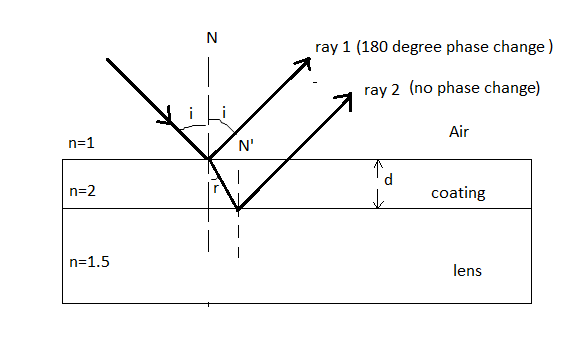1. Suppose you are hired to work in an optics lab which utilizes green laser light at Agreen 532nm for performing a particular optical experiment. If you could reduce reflections from the lens, you could also reduce error in your experiment. You decide to apply an optical coating to your lens, but you need to determine how thick the coating should be to minimize reflections. The index of refraction of the optical coating is n₂ = 2.0, the index of refraction for the lens is n3 = 1.5 and the index of refraction for air is n₁ = 1.0. Let the thickness of the coating be represented by the etter d. A. Draw a diagram (like the one done in class) which illustrates light traveling through air, the coating and your lens. Show the reflection and transmission of the light at each boundary. Be sure to label the index of refraction of each medium and any other relevant information for the problem. Make a list of knowns and unknowns. B. Explain in words what happens to the laser light as it passes the discontinuity between air and the optical coating. Explain in words what happens to the laser light as it passes the discontinuity between the optical coating and the lens. Are the two reflected waves "in phase" or "out of phase" with each other? Explain. Be sure to label any phase shifts on your diagram in part (a). C. D. The coating you are using is very expensive, so you want it to be as thin as possible. Derive a symbolic expression for the depth d of the thinnest possible coating that will eliminate reflections of the incoming green laser light. Check the validity of your expression from part C using at least two sensemaking techniques learned in class then evaluate this expression to find the depth d in nanometers. Evaluate this expression to find the depth d in nanometers. E. Suppose you use the lens coated for green light for an experiment which uses red laser light at Ared 633nm. Do the reflected waves interfere constructively, destructively or somewhere in between? Explain in a sentence or two. (Hint: To back up your answer, it may be helpful to find the phase difference of the two reflected waves in terms of 7).
Please show all steps and label all variables. Make sure to format division, multiplaication, and exponents correctly/visibly.

Note: Since we only answer up to 3 sub-parts, we’ll answer the first 3. Please resubmit the question and specify the other subparts (up to 3) you’d like answered.
(a) Light From Air incident on Air- Coating interface with angle of incidence i with respect to normal N. Some part of the light get reflected from the interface (ray 1) and Some part of light gets refracted .Light undergoes refraction bends towards normal because it is travelling From Air (rarer medium) to optical coating (denser medium). The refracted beam undergoes transmission and then incident on coating - lens interface and beam gets reflected as (ray 2).

| Known | Unknown |
| wavelength =532 nm | d (thickness of coating) |
| n1 =1 | |
| n2 =2 | |
| n3 =1.5 |
(b) When light is travelling from denser medium to rarer medium, the phase shift is zero. When light is travelling from rarer medium to denser medium, the phase shift is 180 degrees.
Based on above note we can say that ray 1 undergoes 180 degree phase shift and ray 2 does not suffer any phase shift. The overall phase shift between ray 1 and ray 2 is 180 degree. hence ray 1 and ray 2 are out of phase.
Trending now
This is a popular solution!
Step by step
Solved in 2 steps with 1 images
